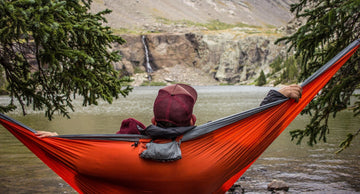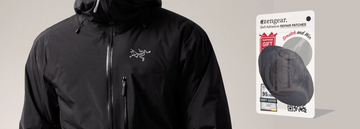Hammocking and Hammock Camping: A Beginner's Guide
by Emily Jannet on Apr 11, 2023
Are you tired of waking up with a sore back after a night of camping on uneven ground? Or maybe you're just looking for a new and exciting way to enjoy the great outdoors. Either way, hammock camping might be just what you need! Hammocks have been around for centuries, but they've recently surged in popularity as a convenient alternative to traditional tents. In this article, we'll introduce you to the basics of hammock camping so you can decide if it's the right choice for your next outdoor adventure.
What is Hammocking?
Hammocking is the act of relaxing or sleeping in a hammock, a type of hanging bed made of fabric or rope. Hammocks have been used for centuries as a comfortable and portable sleeping option, and have recently gained popularity as a camping alternative to traditional tents.
The Benefits of Hammocking
There are many benefits of hammocking. First and foremost, hammocks are incredibly comfortable. They distribute weight evenly and conform to your body, reducing pressure points and increasing circulation. Additionally, hammocks are lightweight and portable, making them an excellent option for backpackers and hikers.
Hammocks also offer unparalleled views of your surroundings. Instead of being confined to the ground, you can elevate yourself and enjoy a bird's eye view of nature. Plus, hammocks are a great way to disconnect from the digital world and unwind in nature.

Choosing a Hammock
When choosing a hammock, there are several factors to consider. First, consider the material. Hammocks come in a variety of materials, including nylon, polyester, and cotton. Nylon is the most popular option as it is lightweight, durable, and quick-drying.
Next, consider the size of the hammock. Hammocks come in various sizes, from single-person to family-sized options. Single-person hammocks are typically 4-5 feet wide, while family-sized hammocks can be up to 10 feet wide.
Finally, consider the weight capacity of the hammock. Make sure the hammock can support your weight plus any gear you plan to bring with you.
Hammock Suspension Systems
In addition to the hammock itself, you will also need a suspension system to hang the hammock. There are several suspension systems available, including straps, ropes, and webbing.
Straps are the most popular option as they are easy to use and don't damage trees. Look for straps with a weight capacity of at least 400 pounds and a length of 10-15 feet.
Hammock Accessories
There are several accessories that can enhance your hammocking experience. A bug net is essential if you plan to hammock in buggy areas, while a rainfly can protect you from the elements. A hammock underquilt or sleeping pad can provide additional insulation and warmth on cold nights.
Setting up a Hammock
Setting up a hammock is relatively straightforward. First, find two sturdy trees at least 12-15 feet apart. Wrap the straps around the trees and clip the carabiners onto the loops of the hammock. Adjust the tension of the straps to achieve the desired height and sag.
Hammock Camping vs. Traditional Camping
Hammock camping offers several advantages over traditional camping. First, it is more comfortable as you are suspended above the ground and can adjust your sleeping position as needed. Additionally, hammocks are lighter and more compact than tents, making them an excellent option for backpacking and hiking trips.
Hammock camping also allows for more flexibility in choosing a campsite. You don't need to find a flat, clear area to pitch a tent, as long as there are two sturdy trees, you can set up your hammock anywhere.
Choosing a Hammock Campsite
When choosing a hammock campsite, there are a few factors to consider. First, make sure the trees you plan to use are sturdy and healthy. Avoid using trees with dead or weak branches that may break under the weight of your hammock.
Next, consider the distance between trees. The trees should be at least 12-15 feet apart to ensure a comfortable sleeping position. Also, make sure there is no dangerous wildlife or hazards in the area.
Hammock Camping Gear
In addition to your hammock and suspension system, there are several other pieces of gear you will need for hammock camping. A sleeping bag or quilt is essential to keep you warm on chilly nights, while a sleeping pad or underquilt can provide additional insulation and comfort.
You will also need a backpack to carry your gear, as well as cooking equipment and food if you plan to cook your meals at the campsite.
Hammock Camping Tips
Here are some tips to make your hammock camping trip more enjoyable:
- Practice setting up your hammock at home before your trip to ensure a quick and easy setup at the campsite.
- Always hang your hammock at the proper height and tension to ensure a comfortable sleeping position.
- Use a sleeping bag or quilt designed for hammock camping to prevent heat loss from underneath.
- Use a rainfly to protect yourself from rain and wind, and a bug net to keep insects at bay.
- Bring a headlamp or flashlight for nighttime use.
Hammock Safety
While hammocks are generally safe, there are a few things to keep in mind to ensure your safety:
- Always use sturdy trees or other sturdy anchors to hang your hammock.
- Check the weight capacity of your hammock and suspension system to ensure it can support your weight.
- Avoid using hammocks near cliffs or other dangerous areas.
- Check the weather forecast before your trip and be prepared for changes in weather.
Environmental Considerations
- When hammock camping, it's important to minimize your impact on the environment. Here are some tips:
- Avoid hanging your hammock on fragile trees or vegetation.
- Use established campsites whenever possible to minimize your impact on the environment.
- Follow the "leave no trace" principles and pack out all of your trash.
Conclusion
Hammocking and hammock camping can be a fun and comfortable way to enjoy the great outdoors. With the right gear and safety precautions, you can experience the benefits of hammocking while camping, backpacking and exploring nature. One of the main advantages of hammock camping is that it allows you to sleep off the ground, away from rocks, roots, and other uneven terrain that can disrupt your sleep and leave you feeling achy in the morning. Additionally, hammocks are lightweight, compact, and easy to set up, making them a popular choice for backpackers who need to carry their gear long distances. However, before you jump into hammock camping, it's important to understand the equipment you'll need, the potential risks involved, and the best practices for staying safe and comfortable in the wild.





